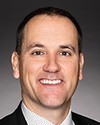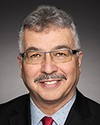Mr. Albas.
Evidence of meeting #111 for Finance in the 42nd Parliament, 1st session. (The original version is on Parliament’s site, as are the minutes.) The winning word was innovation.
Evidence of meeting #111 for Finance in the 42nd Parliament, 1st session. (The original version is on Parliament’s site, as are the minutes.) The winning word was innovation.
Conservative

Dan Albas Conservative Central Okanagan—Similkameen—Nicola, BC
Thank you to all the witnesses. I have to say this is one of the finest panels. There is a lot of food for thought. Thank you each for your contribution.
I'm going to start with the Saskatchewan Mining Association. Thank you very much for being here.
I received an email from the Klondike Placer Miners' Association in regard to their input on the proposed tax changes, which are receiving a lot of scrutiny in Ottawa. Where are your members at in regard to that? Do you have a large number that are private corporations versus publicly traded?
President, Saskatchewan Mining Association
Most of our members are publicly traded. We have a couple that would be more state-owned enterprises, but most of them are large global publicly traded companies.
Conservative

Dan Albas Conservative Central Okanagan—Similkameen—Nicola, BC
In regard to the implementation, you raised questions about the government's approach to cannabis regulation, specifically safe workplaces. It's my understanding that cannabinoids can stay in the fat cells for two weeks and cannot be detected per se until some form of adrenaline happens, and then they get released into the system causing, basically, a new high.
How do you deal with something as complicated as this? Alcohol is usually completely gone from the system within 24 hours.
President, Saskatchewan Mining Association
That's part of the problem. We're not sure how we're going to deal with it. I don't think anybody is sure. There's no real good testing mechanism in place that's not really invasive. That would cause human rights issues in terms of the fact that you can't go around giving somebody a blood test.
Conservative

Dan Albas Conservative Central Okanagan—Similkameen—Nicola, BC
That's a very good question, because it's not just even if you had a magic device that could accurately do that, but who would administer the test? In a unionized environment, would it be the union or would it be the company? Many people might say that there are privacy issues there.
President, Saskatchewan Mining Association
There likely are. This is a really important issue. There's no issue that's more important to the mining sector than safety. We cannot afford to have people injured or killed because of a rush to put in place a policy that is not well thought out in our minds. There may be a time that it's appropriate, but from my read of submissions, there are very few medical associations, very few police enforcement officials, certainly no mining industry representatives who—
Conservative

Dan Albas Conservative Central Okanagan—Similkameen—Nicola, BC
Your regulator that handles WorkSafe, do they have any guides or forward guidance on how to deal with this issue?
President, Saskatchewan Mining Association
They're part of working committees right now, but they have nothing in place.
Conservative

Dan Albas Conservative Central Okanagan—Similkameen—Nicola, BC
You as an industry right now don't have any instructions about how you're going to adapt to this new legalization?
President, Saskatchewan Mining Association
No, we don't even know if there will be an impairment level.
Conservative

Dan Albas Conservative Central Okanagan—Similkameen—Nicola, BC
In regard to timelines.... Again, I totally understand that it's very important to have consistency. You have to have certainty for business, particularly in your sector. I have two copper mines in my area, and both of them require large amounts of foreign direct investment. People tend not to want to invest in a country if there's no certainty.
In regard to species at risk, you said that you would like to see a landscape approach versus a species at risk approach. Could you elaborate on that?
President, Saskatchewan Mining Association
Right now, we're seeing basically a waterfall approach to designation of different species that are either endangered or threatened. As soon as something becomes threatened and listed, a recovery strategy is required that talks about what activities might be permissible. However, the problem is a number of these species have competing habitat requirements. For example, in Saskatchewan, cariboo would require winter forests, but the olive-sided flycatcher doesn't like mature forests. Both are threatened and both have the same range, so what do you do? You can't do anything that satisfies both.
We need to look at the landscape as a whole. There is a project in southern Saskatchewan called South of the Divide, that the Minister of Environment and Climate Change and Environment Canada are looking at, which would provide a more balanced landscape approach to provide protection to species across the board. I would refer to that approach.
Right now, there's no current mechanism in place to support a lot of this work.
Conservative

Dan Albas Conservative Central Okanagan—Similkameen—Nicola, BC
First of all, just let me thank you for the work that you do, because mining is one of the most innovative areas. There's lots of technology used there. There are lots of jobs for indigenous people, as well as the general population. That's exactly the kind of economic development we should continue to support.
Liberal

The Chair Liberal Wayne Easter
I'll have to cut you off there, Dan.
Mr. McLeod, you have five minutes.
Liberal

Michael McLeod Liberal Northwest Territories, NT
Thank you, Mr. Chair.
Thank you, to all of you, for your presentations. It's my first time being involved in a pre-budget consultation, and there have been some very good presentations here today.
My first question is for Pam. It's good to see you again, wearing a different hat this time. I have a couple of questions.
You raised concerns about the proposed marijuana legislation coming forward, and not being able to test. Could you tell me what you're doing now to test? What's going to be different that won't allow you to do the testing you're currently doing?
President, Saskatchewan Mining Association
It's going to be a different environment.
The only way you can have people who have used marijuana in a workplace is if they're not in a safety sensitive position and they have a prescription. You can control the people who are legally using marijuana.
Right now you're not allowed to test somebody on a random basis. You have to have a reason to test, and usually that's triggered because there has been an accident. We don't want to have to wait for an accident to happen before we can test somebody, because that accident could hurt or kill somebody.
Liberal
President, Saskatchewan Mining Association
Absolutely. The risk of people using a legal substance will increase, and the impairment effects can be much longer lasting with marijuana than on other substances such as alcohol.
Liberal

Michael McLeod Liberal Northwest Territories, NT
You mentioned that there was no real ask in your presentation today.
I represent the Northwest Territories, and we have a large mining industry in that part of the country. We have a good relationship. They're the backbone of our economy.
However, they still feel that the mineral tax credit is something that is very important to continue with. We have discussions regarding the benefits of either a tax credit or more infrastructure. As a politician, I want to see that the investment attractiveness is improved.
Given that we are a jurisdiction with very little in terms of roads, good airports, bridges, would you say there should be a priority in remote parts of Canada, where we look at maybe giving the benefit of infrastructure that's going to stay long after the industry is gone?
President, Saskatchewan Mining Association
You know, I would agree with you.
I think the investment in infrastructure is important. When we look at northern Saskatchewan, we have half a dozen gold mines that are literally a stone's throw off Highway 102, which is one of the only roads in northern Saskatchewan. If you have infrastructure, it's going to lower your exploration costs. It's going to help communities in their access to better food and things. If it's a choice, I would invest in infrastructure.
Liberal

Michael McLeod Liberal Northwest Territories, NT
I don't know if I missed it, but I didn't see it as part of your list of what you are recommending.
Regarding the regulatory process and the many different systems across the country, I've had the opportunity to see what is out there and what we have in the Northwest Territories. We certainly have a different and unique process in the Northwest Territories, because half of our boards consist of aboriginal people. It's more of a collaboration between industry, government, and indigenous peoples when we start looking at projects, rather than the historic way of doing things, setting up a project, doing the proposal, and then trying to sell it. It seems to be well received, and the regulatory bodies are asked to present all over the world on the system. It's been really popular in many, many different countries.
You mentioned a few places that you suggested we look at in terms of regulatory models. Is there one in Canada that you could point to that maybe we could start working towards as a goal?
President, Saskatchewan Mining Association
I know there are pros to the model in the territories. I also know there have been some issues with some water boards and things like that.
Northern Saskatchewan and the federal government actually had a joint federal-provincial uranium panel back in the 1990s that worked very well. The panellists were professionals, scientists, but also Vice-Chief John Dantouze was one of the three panel members. Community members were very involved in the hearings and the process. Don Lee, a chemistry professor from the University of Regina was the chair. I actually had the benefit of participating in that. I think that was a good model. It had provincial-federal harmonization. It had a lot of community participation and input. It was a very open and transparent process.